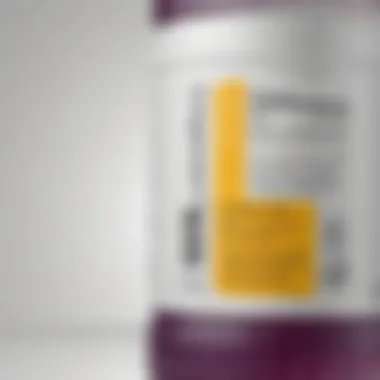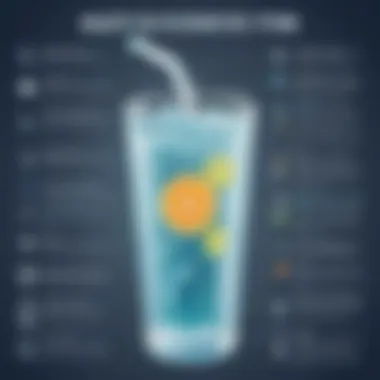Exploring Electrolytes: A Guide to Hydration Options


Intro
Electrolytes are essential substances in our body that help regulate a variety of critical functions. They include minerals like sodium, potassium, calcium, magnesium, and others, ensuring our cells operate effectively. As such, it’s important to understand how to replenish electrolytes, particularly through beverages we often consume.
In this article, we will look at various drink options available for those looking to increase their electrolyte intake. We will touch on both natural sources, like coconut water and certain fruits, and commercial products such as sports drinks. Through understanding these drink options, parents and young science enthusiasts will gain insight into proper hydration and nutrition.
Science Fun Facts
- Did you know? The human body contains about 25 grams of magnesium, a vital electrolyte. ( source: Wikipedia)
- Interesting Fact: Sodium is often viewed negatively, but it is critical for maintaining fluid balance in the body.
- Curious Recovery: Top-level athletes often drink electrolyte beverages to swiftly recover after extreme exertion, as they lose important minerals through sweat.
- Historical Insight: The first commercial sports drink, Gatorade, was developed in 1965 to help Florida Gators athletes stay hydrated and enhance performance.
Important Note: Electrolytes are not just for athletes. Everyone can benefit from them, especially during high temperatures, exercise or illness.
Exploring Various Drink Options
In the realm of electrolyte-infused beverages, variety flourishes. These can range from natural products to scientific innovations. Here are some snacks and drinks to consider:
Natural Sources
These options can typically be found in your kitchen or at the grocery store.
- Coconut Water: A low-calorie choice that is rich in potassium and magnesium.
- Fruit Juices: Options like orange juice or watermelon juice can replenish lost fluids and essential minerals.
- Homemade Sports Drinks: Mix water with natural fruit juices and a pinch of salt for an inexpensive electrolyte drink.
Commercial Options
Specialized drinks are marketed directly towards replenishing electrolytes.
- Gatorade and Powerade: These sports drinks offer a mixture of sugars, electrolytes, and flavors meant to quickly hydrate.
- Electrolyte Tablets: Watery or fizzy tablets that dissolve in water, providing portable hydration solutions.
- Nutricionals: Some protein shakes or health products even add electrolytes for added benefit.
Educational Insights
Understanding how these drinks work help us pursue healthier lifestyles. Electrolytes play vital roles that extend beyond hydration; for example, they are crucial for heart and muscle functions. Choosing the right drink can significantly affect energy levels during daily activities or athletic performance. That’s why parents and children alike should understand which options are best suited for their specific needs.
Final Words
Embarking on this journey of understanding electrolytes through drinks opens doors for better hydration, health learning, and preparing delicious natural options at home. Observe and experiment with what tastes good while providing necessary minerals.### Prompt your curiosity and guide hydration decisions effectively.
Prologue to Electrolytes
Electrolytes are essential minerals found in the body. They help regulate nerve and muscle function, hydrate the body, balance blood acidity, and help rebuild damaged tissue. The direct impact of these minerals on our health and well-being is significant.
In this section, we focus on what electrolytes are and why they are important. Understanding these aspects can help individuals make educated decisions when choosing drinks and food. Since electrolyte imbalance can lead to various health issues, knowing the sources and signs of this imbalance is crucial for everyone, including children and their caregivers.
What Are Electrolytes?
Electrolytes are electrically charged minerals. Examples include sodium, potassium, calcium, magnesium, chloride, bicarbonate, and phosphate. These minerals dissolved in body fluids contribute to electrical activity. They are vital in maintaining communication between nerves and muscles with the body.
Hypernatremia and hyponatremia are conditions arising from abnormal sodium levels. These conditions highlight that not getting enough electrolytes can cause problems like muscle cramps and confusion. Understanding the origins and roles of these minerals supports a proactive approach to proper hydration.
Why Electrolytes Matter
Electrolytes matter for several reasons. First, they play a key role in hydration. Fluids taken in without electrolytes may not contribute to proper hydration levels. For instance, water is hydrating, but adding sources of electrolytes like coconut water or sports drinks enhances its benefits.
Second, electrolytes are essential for bodily functions. They facilitate muscle contractions, including the cardiac muscle. An adequate supply of these minerals can help sustain stamina and overall energy during physical activity.


Third, electrolyte balance is crucial. Factors such as dehydration, illness, or excessive sweating can significantly disrupt this balance. Thirst is one sign that your body requires electrolytes. Therefore, it is important for caregivers to observe hydration levels in children, especially during physical activity.
Understanding electrolytes can empower people to make healthier hydration choices. It can shape both general well-being and fine-tune athletic performance.
Parents and guardians should look for drinks rich in these nutrients. With proper knowledge, they can confidently support the hydration needs of their fmaily.
Types of Electrolytes
Understanding the types of electrolytes is essential for grasping how they function in the body. Electrolytes are ions that help in various bodily functions, including muscle contraction, hydration, and nerve signalling. Knowing about their specific roles helps individuals to make informed choices regarding nutrition and hydration. Each type of electrolyte serves its unique purpose, contributing to overall well-being.
Sodium
Sodium is often seen as a key player among electrolytes. It helps maintain fluid balance in the body, regulates blood pressure, and ensures the proper function of muscles and nerves. A proper balance of sodium is vital. Too much sodium can lead to high blood pressure, while too little can cause hyponatremia, which can trigger nausea or confusion. Good sources of sodium include table salt, soy sauce, and processed foods. However, care must be taken to avoid excessive intake, as the consequences can outweigh the benefits.
Potassium
Potassium also plays an important role in maintaining body functions. It works alongside sodium to help regulate fluid balance. Potassium is particularly critical for heart health. It helps control heart rhythm and can lower blood pressure. Foods rich in potassium include bananas, oranges, and potatoes. Regularly consuming these foods can ensure sufficient potassium levels are maintained. Low potassium levels могут cause weakness and cramps, emphasizing the need for adequate intake.
Calcium and Magnesium
Calcium and magnesium both aid in muscle function and bone health. Calcium is well-known for its role in building and maintaining strong bones. It also helps with muscle contractions. Magnesium, on the other hand, works to relax muscles and is essential in energy production. Foods such as dairy products for calcium and green leafy veggies for magnesium provide these electrolytes. It is key to have the right balance between these two minerals for optimum bodily functions.
Chloride and Bicarbonate
Chloride helps with maintaining fluid balance and is often found in association with sodium. It aids in digestion, particularly the production of stomach acid. Bicarbonate, in simple terms, acts as a pH buffer, stabilizing blood pH. It is vital for reacting to changing acid levels in the body. Good food sources of chloride include table salt, while bicarbonate can be obtained through various metabolic processes. Insufficient levels of bicarbonate may affect the body's ability to maintain a stable pH, causing various physiological issues.
Natural Sources of Electrolytes
Understanding the natural sources of electrolytes is vital to maintaining a healthy body. Electrolytes help regulate nerve function, keep your body hydrated, and balance your blood acidity levels, among other key functions. Choosing natural sources can provide a simpler, cleaner way to replenish these essential minerals. This section will explore several natural options, including coconut water, fruits, vegetables, and sea salt, all known for their electrolyte content.
Coconut Water
Coconut water stands out as a popular natural beverage due to its refreshing taste and impressive electrolyte profile. Packed with potassium, sodium, and magnesium, coconut water serves as an effective drink for hydration. Beyond its nutritional components, it is also low in calories and offers a mild sweetness without added sugar. This makes it a great alternative for those looking to hydrate more healthily after exercise. The unique feature of coconut water is its isotonic nature, meaning it can closely match the human body's electrolyte balance. However, it is crucial to consume it in moderation, as excessive intake may lead to an imbalance of nutrients.
Fruits and Vegetables
Fruits and vegetables are excellent, natural sources of electrolytes that are easy to incorporate into a daily diet. They not only contain crucial minerals but also provide fiber and vitamins. Highlights among these include:
Bananas
Bananas are often highlighted for their high potassium content, essential for nerve function and muscle contraction. The key characteristic of bananas is their easily digestible form of carbohydrates, providing quick energy. They are especially beneficial for athletes who need a fast energy boost. One of the unique features of bananas is their high levels of tryptophan, which help to promote feelings of well-being. They do not contain excessive calories or fat, making them a popular choice.
Spinach
Spinach is another powerhouse of electrolytes, particularly magnesium and calcium. The key characteristic of spinach is that it is a leafy green vegetable packed with a mix of essential vitamins. This green can help regulate fluid control. One unique aspect of spinach is its ability to aid in digestive health due to its high fiber content. This advantage makes it integral to a balanced diet. However, spinach contains oxalates, which can inhibit the absorption of certain minerals, so variety is key.
Oranges
Oranges are frequently viewed as a refreshing whole-fruit option. Known for their high vitamin C content, they also provide important amounts of sodium and potassium. Oranges’ key characteristic is their juicy and sweet taste, allowing them to be an enjoyable source of electrolytes. They are also hydrating due to their water content. A remarkable feature of oranges is their potential antioxidant properties, which may offer additional benefits. Although oranges are beneficial, they should be consumed whole most of the time, as fruit juices can lead to excess sugar intake.
Sea Salt
Lastly, sea salt is not just a seasoning but a crucial natural source of key electrolytes like sodium and chloride. Collecting sea salt from coastal regions elevates its popularity in cuisine. The main advantage lies in its ability to replenish lost sodium during exercise and heavy sweating. However, while adding flavor to food, it is important to consume it judiciously. Excessive salt intake has been linked to various health issues, including hypertension. Proper amounts are necessary for maintaining electrolyte balance in both high and low activity levels.


Maintaining a balanced intake of natural electrolytes ensures optimal hydration and health benefits.
Commercial Drinks Containing Electrolytes
Electrolytes are not only found in natural sources, but also in a variety of commercial drinks. These options become increasingly popular for individuals seeking effective hydration strategies. Understanding these drinks can empower parents, caregivers, and young science enthusiasts alike to make informed choices that support healthy living. In the realm of hydration, these beverages can vary widely in their composition, dosage, and claims about what they provide for your health.
Sports Drinks
Sports drinks are specifically formulated to help replenish electrolytes lost during physical activities. They often contain crucial electrolytes like sodium and potassium. The primary appeal of these drinks is their rapid hydration capacities, which becomes vital for athletes or active individuals. Brands such as Gatorade and Powerade are commonly known for their flavors that aim to appeal to consumers while delivering necessary nutrients.
Benefits
- Quick absorption: Its carbohydrate content helps immediate absorption.
- Flavor varieties: Options cater to those who might otherwise dislike plain water.
Considerations
While sports drinks have their undeniable advantages, they often contain added sugars and artificial flavors. Parents should scrutinize ingredients to, select options with lower sugar content, especially for children who are not highly active.
Electrolyte Powders and Tablets
Electrolyte powders and tablets provide a convenient way to create your own hydration mix. These cost-effective solutions dissolve easily in water, offering a straightforward means to customize your drink. Brands like Nuun or Liquid I.V. provide options packed with electrolytes needed for both daily activities and workouts. These solutions often contain minimal sugar or none at all.
Benefits
- Personalization: Users can control the concentration of electrolytes
- Portability: Easily carried on the go makes them ideal for travel or outdoor exercise.
Considerations
A review of labels is advisable. Some products may rely on sweeteners, while not all offer a broad spectrum of electrolytes. Activites requiring longer hydration periods necessitate reliable options per individual needs.
Flavored Water
Flavored waters have emerged as a stylish upgrade to regular water. These drinks claim to inject essential nutrients but largely focus on taste. Options such as Hint and Perrier Sparkling Water launch out on the market, with many advertising added vitamins and minerals, including electrolytes.
Benefits
- An attractive alternative: For those who can’t choose water due to lack of taste, flavored waters provide a bridge.
- Variety: With multiple flavors available, hydration doesn’t feel like a chore anymore.
Considerations
Yet, reading labels is essential here too. Some flavored waters might still contain chemical additives or sugar substitutes. Knowing these ingredients can ensure healthier consumption. As we learn and adjust our hydration habits, recognizing whether we need electrolytes should help you decide which drink is worth trying.
In summary, commercial drinks containing electrolytes come in distinct types and formulations. They offer unique advantages but require careful consideration for well-informed choices around health and nutrition.
Homemade Electrolyte Drinks
Homemade electrolyte drinks serve as an accessible option for many families. Making these drinks at home allows parents and caregivers to control the ingredients and customize the flavors. Unlike commercial beverage options, homemade variants can be made with all-natural components, which avoids additives, preservatives, or excessive sugar. As hydration remains essential for overall health, creating these drinks is an important skill in the realm of nutrition.
Simple Recipes
Honey Lemonade
Honey lemonade is a straightforward yet beneficial way to consume electrolytes. This drink combines water, fresh lemon juice, honey, and salt. Lemons are a notable source of vitamin C, and honey adds a natural sweetness while also providing some minerals.


The key characteristic of honey lemonade is its simplicity and tasty flavor combination. Many children enjoy the slight tartness of the lemonade balanced by the sweetness from honey, making it a favorable choice for hydration. One unique feature of this drink is that honey not only sweetens but also acts as an antimicrobial agent, possibly boosting health benefits further. However, excessive amounts of honey can lead to high sugar intake, so moderation is important when preparing this drink.
Salt and Citrus Drink
The salt and citrus drink embodies another simple method for creating homemade electrolyte solutions. This drink often combines water, salt (such as sea salt), and a variety of citrus fruits, such as orange, lemon, or lime, to enhance flavor. The salt reintroduces essential sodium, while the citrus adds also potassium and other vitamins.
The main advantage of this drink lies in balancing hydration and necessary minerals. Just like honey lemonade, it provides crucial rehydration during physical activities. Another appealing aspect is its flexibility, allowing for various fruits depending on taste preferences or seasonal availability. However, it’s important to adjust salt levels carefully; too much can create an unpleasant taste, especially for younger drinkers.
Benefits of Homemade Solutions
Homemade solutions come with several noteworthy benefits. First, they promote an understanding of dietary choices in families. When parents engage children in the process of making these drinks, it encourages healthier habits. Moreover, homemade drinks can be made according to individual flavor profiles or dietary restrictions, granting parents full control over what goes into each drink.
In addition, these solutions offer cost-effectiveness, using fresh ingredients rather than paying for commercial brands. A simple homemade mixture often proves more economical. Lastly, by preparing drinks at home, families can avoid artificial flavors and colors present in many commercial options, contributing to healthier lifestyle choices overall.
Homemade electrolyte drinks provide a family-oriented approach to hydration. Families can nourish themselves with recognizable ingredients, nurturing key component of a healthy diet.
Hydration and Health
Staying properly hydrated is essential for both physical and mental well-being. It directly influences how we feel and function throughout the day. Having a good balance of electrolytes in our bodies plays a fundamental role in maintaining this hydration. Without the right levels of electrolytes, people can experience a range of issues that may hinder their day-to-day activities.
Adequate hydration is critical for many bodily functions. For example, it's vital in regulating temperature, transporting nutrients, and removing waste. Furthermore, hydration supports cognitive function. When young children or athletes are well-hydrated, they can focus better and perform to their full potential.
Signs of Electrolyte Imbalance
Being aware of the signs of electrolyte imbalance can be invaluable. When electrolyte levels fluctuate, it can lead to symptoms such as:
- Fatigue or weakness
- Muscle cramps or spasms
- Dizziness or confusion
- Nausea or vomiting
- Increased thirst
Children and individuals engaged in strenuous activities are particularly vulnerable to imbalances. They should stay vigilant for these signs, as catching them early can help avoid more serious health issues. If electrolyte levels are not restored, complications could occur. Therefore, being alert to bodily signals is crucial.
Remember, recognizing the signs early can lead to quicker recovery and better health outcomes.
Maintaining Proper Hydration
To ensure proper hydration, it's important to integrate electrolytes into the daily routine. Drinking plain water is not always enough, especially after exercising or during hot weather. Here are several strategies that can be used:
- Consume electrolyte-rich foods, such as bananas and spinach.
- Drink electrolyte-enhanced beverages when engaging in activities that cause sweating.
- Consider homemade solutions, such as honey lemonade, to replenish lost electrolytes in a healthier way.
Keeping an eye on fluid intake is equally important. Parents and caregivers should encourage children to drink periodically. Rather than waiting until they are thirsty, taking sips throughout the day will help maintain hydration levels effectively.
In summary, paying attention to hydration is a key aspect of overall health. Recognizing the signs of electrolyte imbalnce and knowing how to maintain proper hydration can lead to significant improvement in well-being. Making informed choices about beverages that contain electrolytes provides support for active minds and bodies.
Closure
Understanding electrolytes is vital for maintaining health and proper hydration. The insights presented in this article emphasize the diverse options available to replenish electrolytes effectively. This not only aids in recovery from physical activities but also enhances overall well-being.
Summary of Drink Options
Electrolyte drinks vary widely, ranging from natural choices like coconut water to commercial sports drinks like Gatorade. These beverages help restore lost electrolytes due to sweating, illness, or inadequate dietary intake. Key options include:
- Natural Sources: Coconut water, bananas, and spinach provide natural electrolytes without added sugars or artificial ingredients.
- Sports Drinks: These are convenient but may include sugars and artificial flavorings. Popular ones such as Powerade and Propel offer hydration for active children and adults.
- Electrolyte Powders: Supplementing water with powders such as Nuun can create customizable drinks suited to taste and need.
- Flavored Water: Drinks like Vitaminwater give an electrolyte boost in a tasty form but should be used moderately due to sugar content.
Electrolytes are essential for processes like nerve function, muscle contraction, and hydration balance.
Encouraging Healthy Choices
Promoting healthier drink options is crucial. Parents and caregivers can educate children on choosing wisely, which can make a significant difference in their health. Here are easy strategies:
- Read Labels: Understand what goes into drinks. Check for actual electrolytes, sugars, and artificial components.
- Home Recipes: Encourage making drinks at home using simple ingredients. Recipes like honey lemonade or salt and citrus drink are delicious and healthy.
- Variety: Provide a range of options. This makes hydration enjoyable and helps instill good habits from an early age.
- Flavor Association: Teach kids to associate hydration with specific flavors naturally found in fruits and vegetables instead of artificially processed beverages.
Investing time and effort into understanding electrolyte-rich drink choices leads us toward better nutrition and healthier lifestyles for our families.







